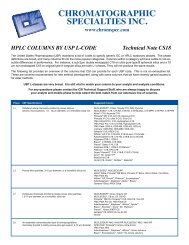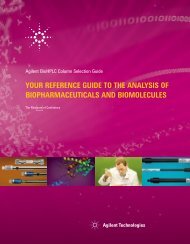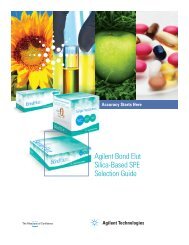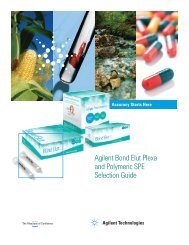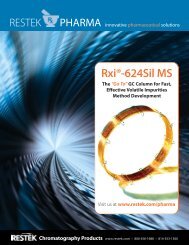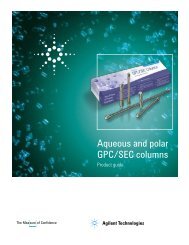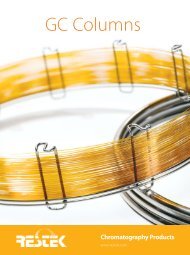Optimizing the Analysis of Volatile Organic Compounds
Optimizing the Analysis of Volatile Organic Compounds
Optimizing the Analysis of Volatile Organic Compounds
You also want an ePaper? Increase the reach of your titles
YUMPU automatically turns print PDFs into web optimized ePapers that Google loves.
50<br />
Advances in Sample Throughput<br />
The demand for increased productivity in<br />
volatiles analysis by GC/MS has resulted in <strong>the</strong><br />
creation <strong>of</strong> automated water and soil autosamplers<br />
that reduce <strong>the</strong> amount <strong>of</strong> manual sample<br />
preparation required. Autosamplers enable<br />
environmental laboratories to run purge and<br />
trap systems around <strong>the</strong> clock. Even though<br />
prices for analyses <strong>of</strong> samples by Methods<br />
8260 and 524.2 have stabilized, laboratories<br />
still push for faster turn-around-time, to get a<br />
better return on capital equipment investments.<br />
This has resulted in a need for columns<br />
that can drastically reduce separation time and<br />
for instruments that can accommodate short<br />
cycle times. Currently, <strong>the</strong> limiting factor in<br />
VOA is <strong>the</strong> purge and trap cycle time, because<br />
it includes an 11-minute purge time followed<br />
by a 6-12 minute bake-out time. A modern GC,<br />
on <strong>the</strong> o<strong>the</strong>r hand, can acquire a sample in 10<br />
minutes or less. To overcome <strong>the</strong> time limitations<br />
<strong>of</strong> <strong>the</strong> purge and trap, connect two purge<br />
and traps, each with its own autosampler unit,<br />
to one GC/MS operating system. Use <strong>the</strong> dualconcentrator<br />
configuration to synchronize <strong>the</strong><br />
steps so while <strong>the</strong> first system is desorbing <strong>the</strong><br />
sample and starting <strong>the</strong> GC/MS analysis, <strong>the</strong><br />
second system is completing <strong>the</strong> bake cycle<br />
and starting to purge <strong>the</strong> next sample to be<br />
desorbed onto <strong>the</strong> column. The Duet ® system,<br />
designed and sold by Tekmar-Dohrmann,<br />
allows communication between <strong>the</strong> two concentrators<br />
for configuration to one GC/MS. The<br />
Duet ® interface gates <strong>the</strong> signals between <strong>the</strong><br />
concentrators to prevent a faster system from<br />
catching up to a slightly slower one and allowing<br />
a double injection. Calibration curves and<br />
quality control samples (QC, MS, MSD) must<br />
be run for each concentrator.<br />
A tracer compound must be added to one <strong>of</strong><br />
<strong>the</strong> concentrators, to eliminate any potential<br />
question as to which purge and trap system<br />
purged/desorbed <strong>the</strong> sample. With this system<br />
it is possible to run 80 samples in 24 hours,<br />
<strong>the</strong>reby increasing output from a single GC/MS<br />
instrument. Figure 47 (page 51) shows an<br />
analysis on an Rtx ® -VMS column according to<br />
US EPA Method 8260B, using <strong>the</strong> correct internal<br />
standards and surrogates. For more information<br />
see <strong>the</strong> literature cited. 14<br />
www.restekcorp.com<br />
Applications Using GC/MS Detection Systems<br />
EPA Methods 8260, 524.2, 624, 8240 and OLM 04.2<br />
Method 8260: Client target lists may remain <strong>the</strong> same as <strong>the</strong> Method 8240 compound list, but<br />
<strong>the</strong> calibration criteria and low detection limits set by Method 8260 are enforced (Figure 48,<br />
page 52). 15 Chromatograms for <strong>the</strong> 8240 compound list can be produced from different GC<br />
oven conditions, different compound concentrations, and altered MS scan windows. Alcohols<br />
analyses require scanning below 35amu because many <strong>of</strong> <strong>the</strong> fragments used to identify <strong>the</strong><br />
spectra for <strong>the</strong>se compounds are between 25 and 35amu. A good example is 2-chloroethanol<br />
– this target analyte purges poorly and does not respond well by MS detection. The best way<br />
to increase sensitivity by MS detection is by changing <strong>the</strong> scan rate to include ion 31, <strong>the</strong><br />
base peak. This also improves <strong>the</strong> ability <strong>of</strong> <strong>the</strong> s<strong>of</strong>tware and <strong>the</strong> analyst to identify alcohols<br />
because it gives more spectral data. The disadvantage <strong>of</strong> this approach is an increase in noise,<br />
producing an overall decrease in sensitivity for all compounds. In Figure 48, <strong>the</strong> second chromatogram<br />
shows an increase in baseline noise as a result <strong>of</strong> <strong>the</strong> lower scan window. A comparison<br />
<strong>of</strong> peak 38 (2-chloroethanol) on <strong>the</strong> two chromatograms clearly shows a significantly<br />
higher response on <strong>the</strong> second chromatogram, despite a lower concentration.<br />
Method 8260 contains many mid-range volatile compounds that are <strong>the</strong> most common nonpetroleum<br />
contaminants in <strong>the</strong> environment. Unfortunately, <strong>the</strong>se compounds tend to exhibit<br />
broad peak shapes due to poor sample transfer from <strong>the</strong> purge and trap, making <strong>the</strong>m difficult<br />
to resolve. Rtx ® -VMS columns were designed using computer-assisted stationary phase<br />
design (CASPD) s<strong>of</strong>tware to improve solubility <strong>of</strong> <strong>the</strong>se analytes in <strong>the</strong> stationary phase, and<br />
thus provide greater separation for <strong>the</strong>se compounds. 16 This tuned selectivity ensures separation<br />
<strong>of</strong> tetrahydr<strong>of</strong>uran/2-butanone, carbon tetrachloride/1,1,1-trichloroethane, and methyl<br />
acrylate/propionitrile. Although <strong>the</strong>se compounds share common ions and have very similar<br />
spectra, <strong>the</strong>y are resolved by retention time difference on an Rtx ® -VMS column (Figure 49,<br />
page 53). Analytes that share ions and coelute on an Rtx ® -624 column, but are resolved by<br />
an Rtx ® -VMS column, include: e<strong>the</strong>r/ethanol, vinyl acetate/ethyl-tert-butyl e<strong>the</strong>r, and tertbutyl<br />
alcohol/methyl-tert-butyl e<strong>the</strong>r. Several <strong>of</strong> <strong>the</strong>se compounds require a lower initial oven<br />
temperature (35°C), which is not shown in <strong>the</strong>se applications.<br />
Higher-boiling volatile compounds, typically branched or substituted aromatic compounds,<br />
provide analytical challenges <strong>of</strong> <strong>the</strong>ir own. Isomers <strong>of</strong> <strong>the</strong> branched aromatic compounds<br />
share <strong>the</strong> same parent ions and cannot be identified accurately by MS alone. The Rtx ® -VMS<br />
phase also was modeled for maximum separation <strong>of</strong> <strong>the</strong> substituted aromatic isomers, such<br />
as 2- and 4-chlorotoluene. The comparison in Table VII shows isomer resolution on four<br />
o<strong>the</strong>r stationary phases, modeled under <strong>the</strong> same conditions, compared to resolution on <strong>the</strong><br />
Rtx ® -VMS phase. The tuned selectivity <strong>of</strong> <strong>the</strong> Rtx ® -VMS phase allows a rapid final GC oven<br />
ramp rate <strong>of</strong> 40°C/min., or faster, <strong>the</strong>reby promoting fast analysis times. Also, initial temperatures<br />
<strong>of</strong> up to 60°C are possible (Figure 49, page 53). This higher initial temperature provides<br />
<strong>the</strong> required separation and allows faster oven cycle times, although some laboratories<br />
prefer to start at 50°C, to better enhance <strong>the</strong> resolution <strong>of</strong> chloromethane from vinyl chloride<br />
(peaks 2 and 3).<br />
Figure 47 (page 51) shows an analysis <strong>of</strong> <strong>the</strong> Method 8260B compound list, using an Rtx ® -<br />
VMS column (20m, 0.18mm ID, 1.0µm film) without cryogenic cooling. Resolution is<br />
greatly enhanced, due to <strong>the</strong> higher efficiency <strong>of</strong> <strong>the</strong> 0.18mm ID column. The desorb flow<br />
rate is set at 40mL/min. for 1 minute. Many laboratories desorb under <strong>the</strong>se conditions for 2<br />
minutes, but <strong>the</strong> Rtx ® -VMS column makes this unnecessary, because <strong>the</strong> higher flow rate<br />
will desorb <strong>the</strong> volatiles from <strong>the</strong> trap in less than a minute.<br />
Table VII.<br />
An Rtx ® -VMS column best separates 2- and 4-chlorotoluene.<br />
Retention Time (min.) Rtx ® -VMS Rtx ® -624 Rtx ® -502.2 Rtx ® -VRX Rtx ® -1<br />
2-Chlorotoluene 8.35 8.63 8.80 8.49 8.38<br />
4-Chlorotoluene 8.44 8.69 8.84 8.53 8.41<br />
RT diff. 0.09 0.06 0.04 0.04 0.03





